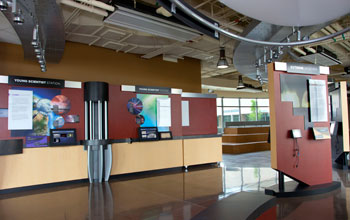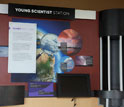News Release 12-195
National Science Foundation Dedicates Wyoming Supercomputing Center
NSF’s National Center for Atmospheric Research will manage the facility

The NCAR-Wyoming Supercomputing Center will include a visitor center.
October 15, 2012
This material is available primarily for archival purposes. Telephone numbers or other contact information may be out of date; please see current contact information at media contacts.
The National Science Foundation (NSF) dedicated the NCAR-Wyoming Supercomputing Center (NWSC), its first facility in decades in Wyoming and one of the world's most powerful supercomputers, as part of dedication ceremonies held in Cheyenne today.
"The NCAR-Wyoming Supercomputing Center will offer researchers the opportunity to develop, access and share complex models and data at incredibly powerful speeds," said NSF Director Subra Suresh. "This is the latest example of NSF's unique ability to identify challenges early and make sure that the best tools are in place to support the science and engineering research communities."
The NWSC will be managed by NSF's National Center for Atmospheric Research (NCAR). The supercomputer, known as "Yellowstone," has the ability to work at 1.5 petaflops--equal to 1.5 quadrillion (a million billion) mathematical operations per second. Its speed is comparable to 7 billion people (the world population) each simultaneously conducting 200,000 calculations a second.
Yellowstone's capabilities will improve scientific understanding of climate change, severe weather, air quality, and other atmospheric and geosciences research. It allows researchers to address research challenges with software, data storage and management, and data analysis and visualization.
Based in Cheyenne, the NWSC is located on a 24-acre site. It houses high-performance computers, mass storage (data archival) systems, and required mechanical and electrical infrastructure. It is a LEED-certified building, showcasing sustainable technologies as well as energy-efficient design and operation. A main component is a public visitor center that illustrates the types of computational science research that will be carried out by scientists across the nation and explains the impact of that research.
Wyoming is part of NSF's Experimental Program to Stimulate Competitive Research (EPSCoR), which allows the agency to strengthen research and education in science and engineering throughout the United States and improve R&D capacity and competitiveness.
In addition to NSF Director Suresh, the dedication ceremony included Wyoming Governor Matt Mead, University Corporation for Atmospheric Research President Thomas Bogdan, NCAR Director Roger Wakimoto, University of Wyoming Vice President for Research Bill Gern and NSF's Atmospheric and Geospace Sciences Division Director Michael Morgan.
The NWSC, funded by NSF with additional support from the state of Wyoming and a broad public-private consortium, will be a mainstay of U.S. geoscience computing for decades to come. Its extraordinary computing power will enable scientists to capture many aspects of our planet's workings in unprecedented detail. The results will improve forecasting of hurricanes, tornadoes, and other severe storms; map critical supplies of water; boost predictions of wildfire behavior; help protect society from solar disruptions; and address many other concerns.
-NSF-
-
One of the stations at the visitor center will include activities for "young scientists."
Credit and Larger Version
Media Contacts
Dana Topousis, NSF, (703) 292-7750, email: dtopousi@nsf.gov
Related Websites
NCAR-Wyoming Supercomputing Center: http://nwsc.ucar.edu
NCAR-Wyoming Supercomputing Center Opens: https://www2.ucar.edu/atmosnews/news/8122/ncar-wyoming-supercomputing-center-opens
The U.S. National Science Foundation propels the nation forward by advancing fundamental research in all fields of science and engineering. NSF supports research and people by providing facilities, instruments and funding to support their ingenuity and sustain the U.S. as a global leader in research and innovation. With a fiscal year 2023 budget of $9.5 billion, NSF funds reach all 50 states through grants to nearly 2,000 colleges, universities and institutions. Each year, NSF receives more than 40,000 competitive proposals and makes about 11,000 new awards. Those awards include support for cooperative research with industry, Arctic and Antarctic research and operations, and U.S. participation in international scientific efforts.
Connect with us online
NSF website: nsf.gov
NSF News: nsf.gov/news
For News Media: nsf.gov/news/newsroom
Statistics: nsf.gov/statistics/
Awards database: nsf.gov/awardsearch/
Follow us on social
Twitter: twitter.com/NSF
Facebook: facebook.com/US.NSF
Instagram: instagram.com/nsfgov

